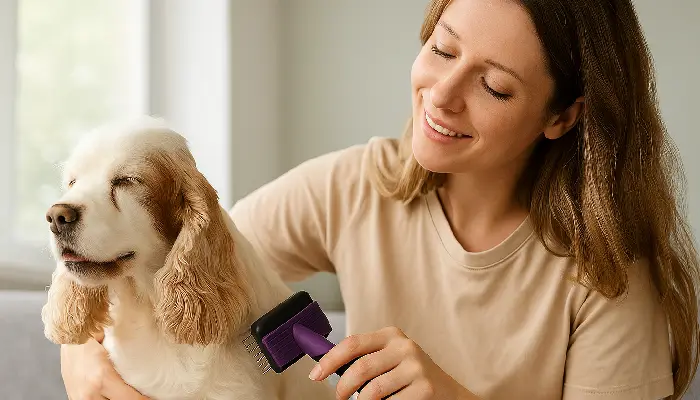How to Properly Brush Your Pet’s Fur (and Make It an Enjoyable Routine)
Brushing your dog or cat is about more than just grooming—it’s a daily ritual that promotes bonding, prevents health issues, and keeps your pet looking and feeling their best. Yet, many pet owners either skip this task or struggle with making it a positive experience.
In this article, you’ll learn how to brush your pet correctly, what tools to use, and how to turn grooming time into a moment of connection and comfort.
Why Daily Brushing Matters
Brushing offers multiple benefits for both dogs and cats:
- Reduces shedding and loose fur around your home
- Prevents tangles and mats, especially in long-haired pets
- Distributes natural oils, promoting a healthy coat and skin
- Removes dirt and debris
- Allows early detection of ticks, fleas, or skin problems
Plus, it’s a great opportunity to bond with your pet and build trust.
Choosing the Right Brush for Your Pet
Different coat types require different grooming tools. Here’s a quick guide:
For Dogs
- Short hair: Rubber curry brush or bristle brush
- Medium/long hair: Slicker brush, de-shedding tool, or undercoat rake
- Curly or wooly coats: Comb plus a slicker brush for detangling
For Cats
- Short hair: Fine-bristle brush or grooming glove
- Long hair: Slicker brush or wide-toothed comb to avoid painful pulling
Avoid using human brushes—they can damage your pet’s coat or irritate the skin.
How to Brush Your Pet: Step-by-Step
1. Choose a Calm Environment
Pick a quiet time and place where your pet feels safe and relaxed. Avoid brushing when they’re overly excited, hungry, or tired.
2. Let Them Smell the Brush
Let your pet inspect the brush before starting. This builds familiarity and reduces anxiety.
3. Start Slowly and Gently
Begin with short strokes on areas they enjoy being touched—like the back or shoulders. Avoid sensitive areas like the belly or tail until your pet is comfortable.
Always brush in the direction of hair growth, and be gentle to avoid pulling or scratching the skin.
4. Check for Tangles, Bumps, or Parasites
As you brush, feel for knots, skin lumps, fleas, or ticks. If you find a stubborn tangle, gently work it out with a detangling spray or a wide-toothed comb.
Never pull a mat forcefully—it can hurt your pet and damage the skin.
5. Offer Treats and Praise
Reward your pet with a treat or kind words after (and even during) the session. This creates a positive association and makes the next session easier.
How Often Should You Brush?
- Short-haired dogs and cats: 1–2 times per week
- Long-haired or double-coated breeds: Daily
- Heavy shedders (e.g., Huskies): Daily during shedding seasons
Regular brushing is especially important for pets with allergies or sensitive skin.
Tips to Make Brushing Easier Over Time
- Keep sessions short—5 to 10 minutes is enough to start
- Brush after playtime or a walk when your pet is more relaxed
- Don’t force it—if your pet resists, stop and try again later
- Use pet-friendly detangling sprays if needed
- Make it part of your daily routine, like brushing your own hair
Brushing Time = Bonding Time
With a little patience and the right tools, brushing becomes more than just a grooming task—it becomes a way to care for your pet, understand their body, and strengthen your relationship.
Whether you have a fluffy cat or a sleek-coated pup, a few minutes a day with a brush can lead to a happier, healthier pet—and a lot less fur around your home.

